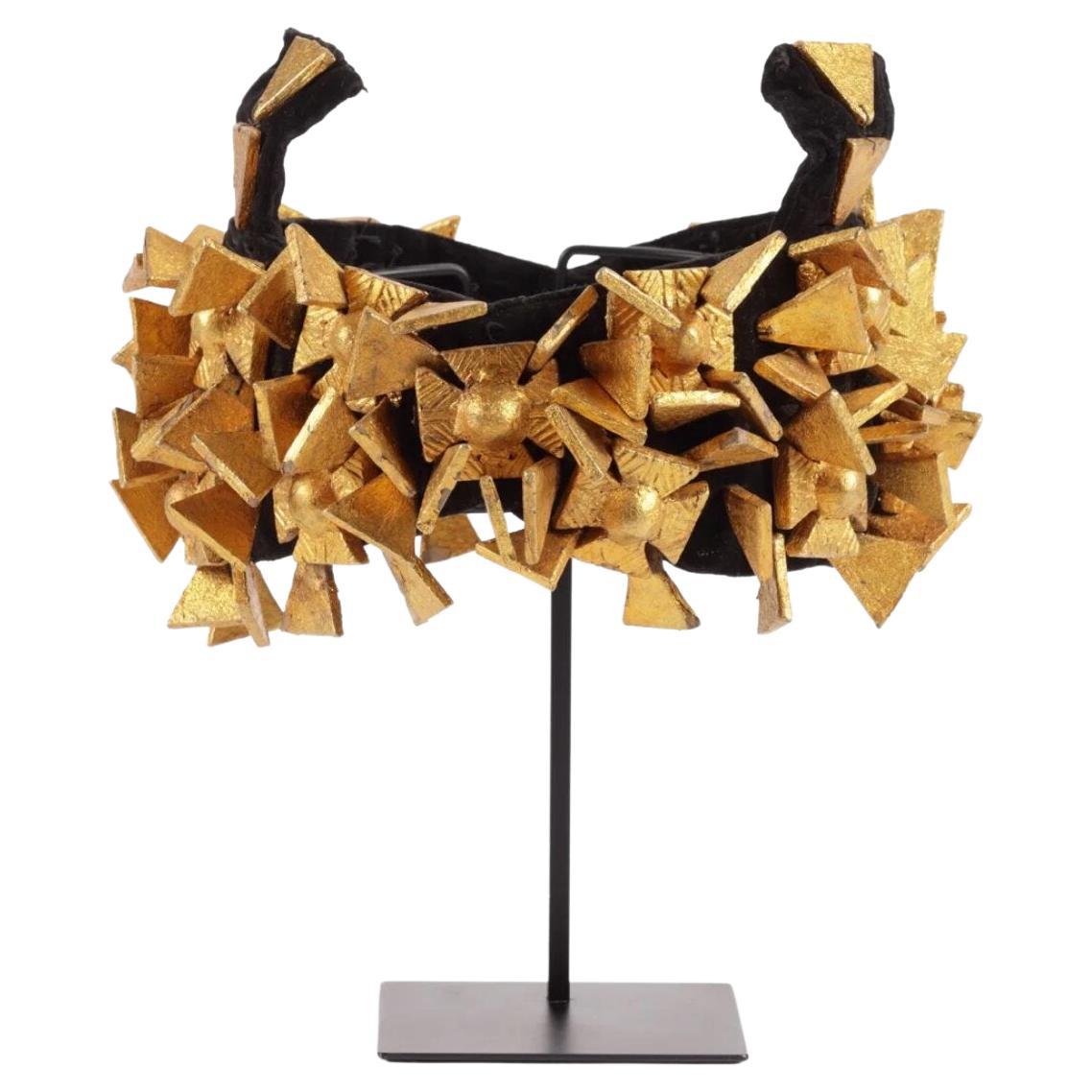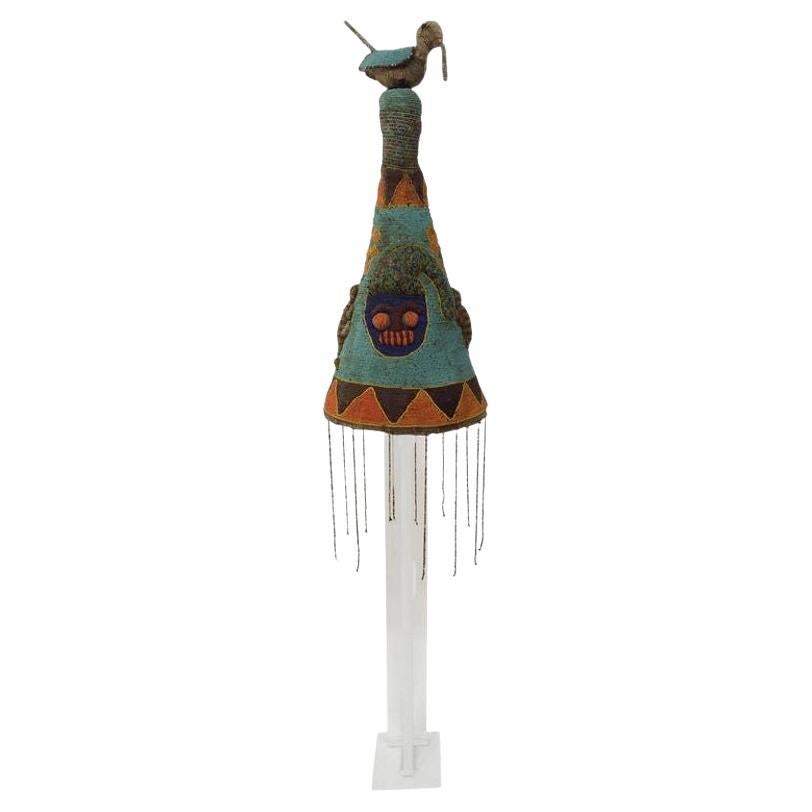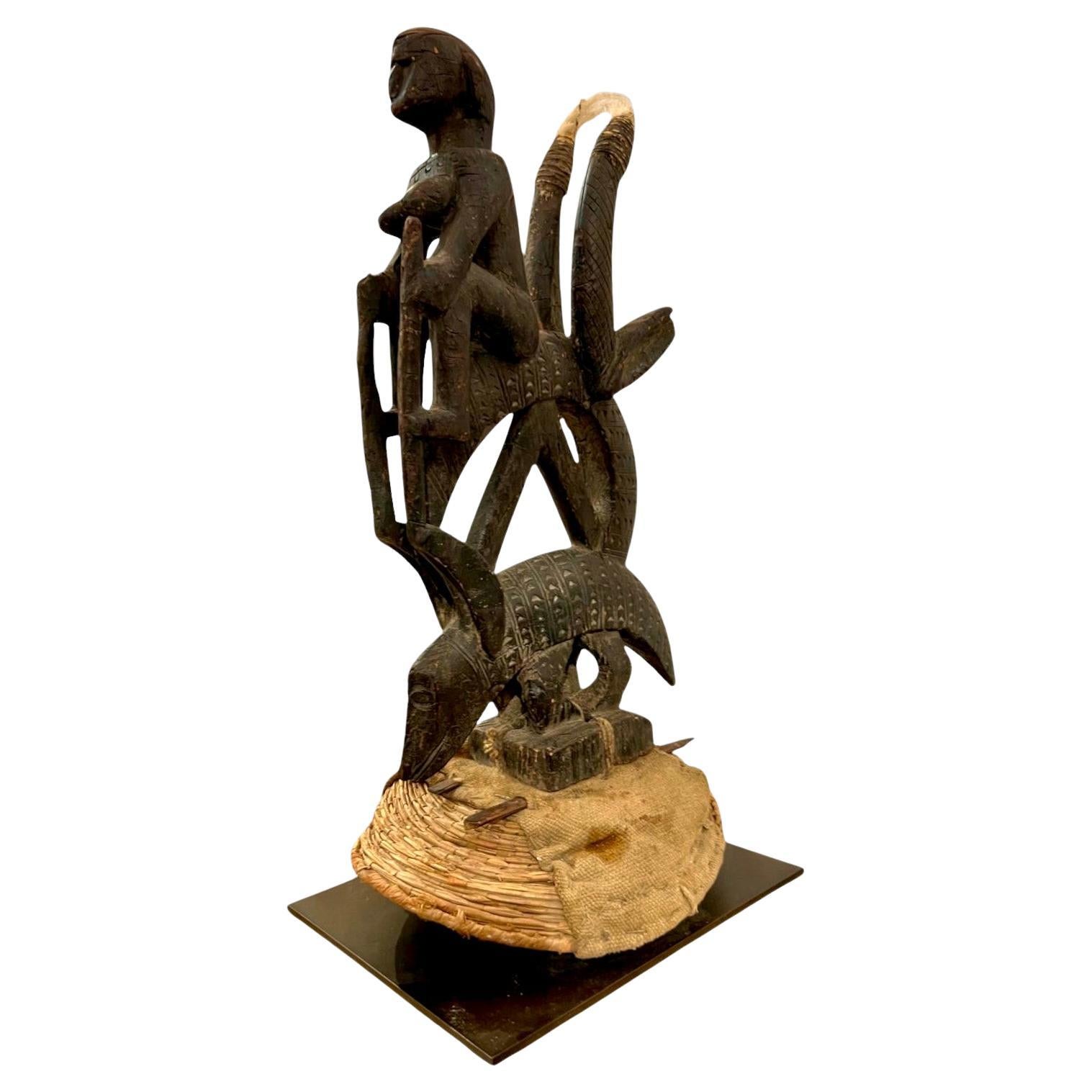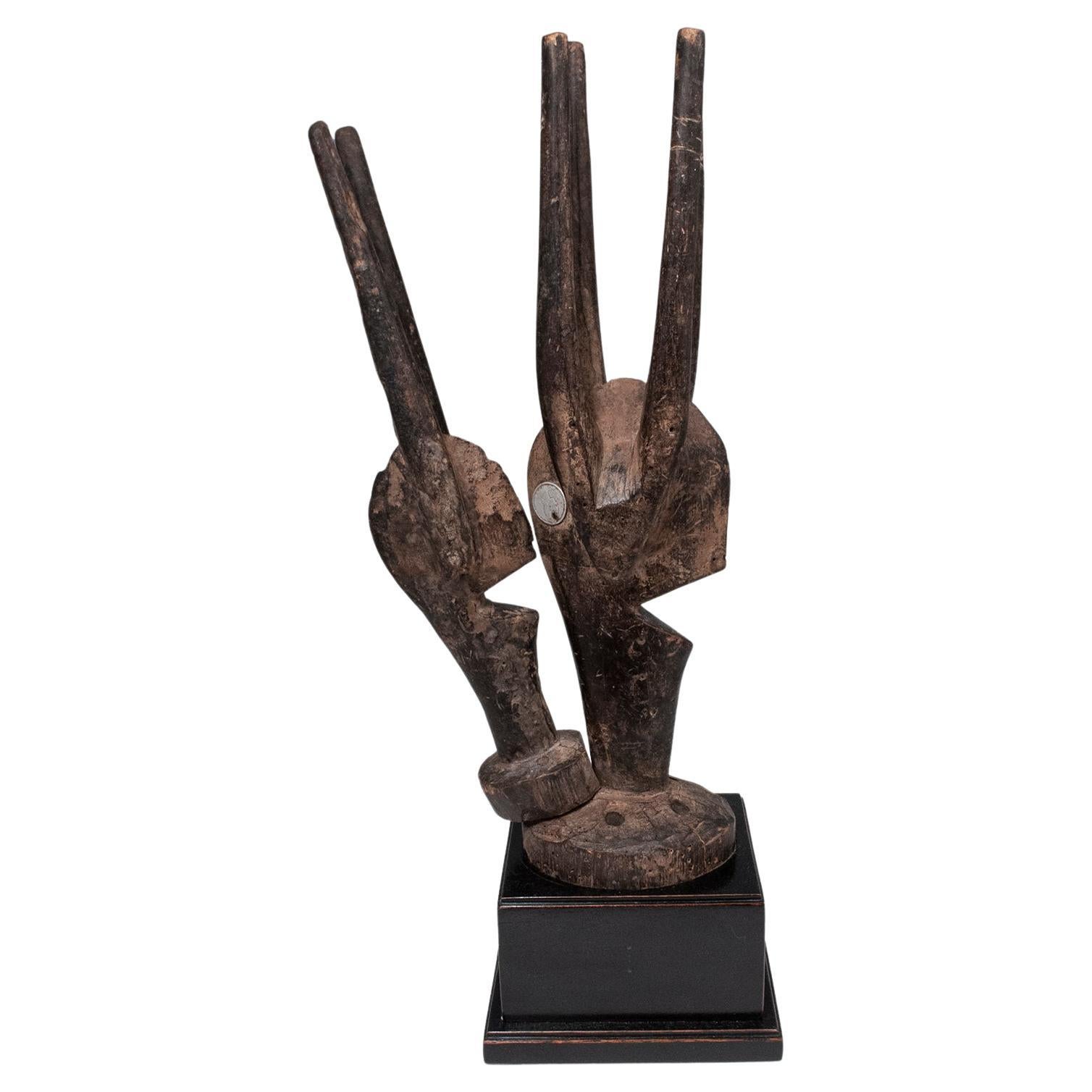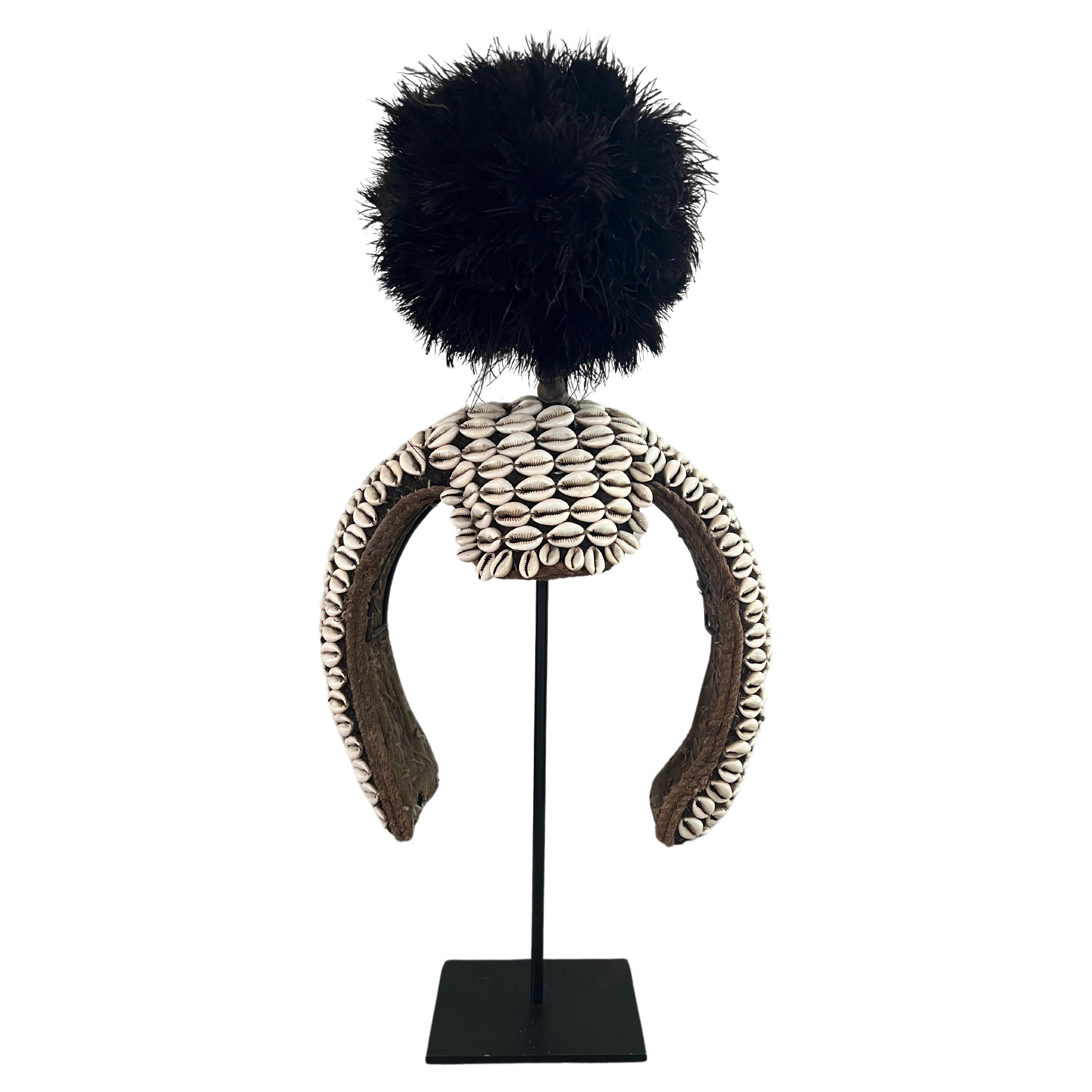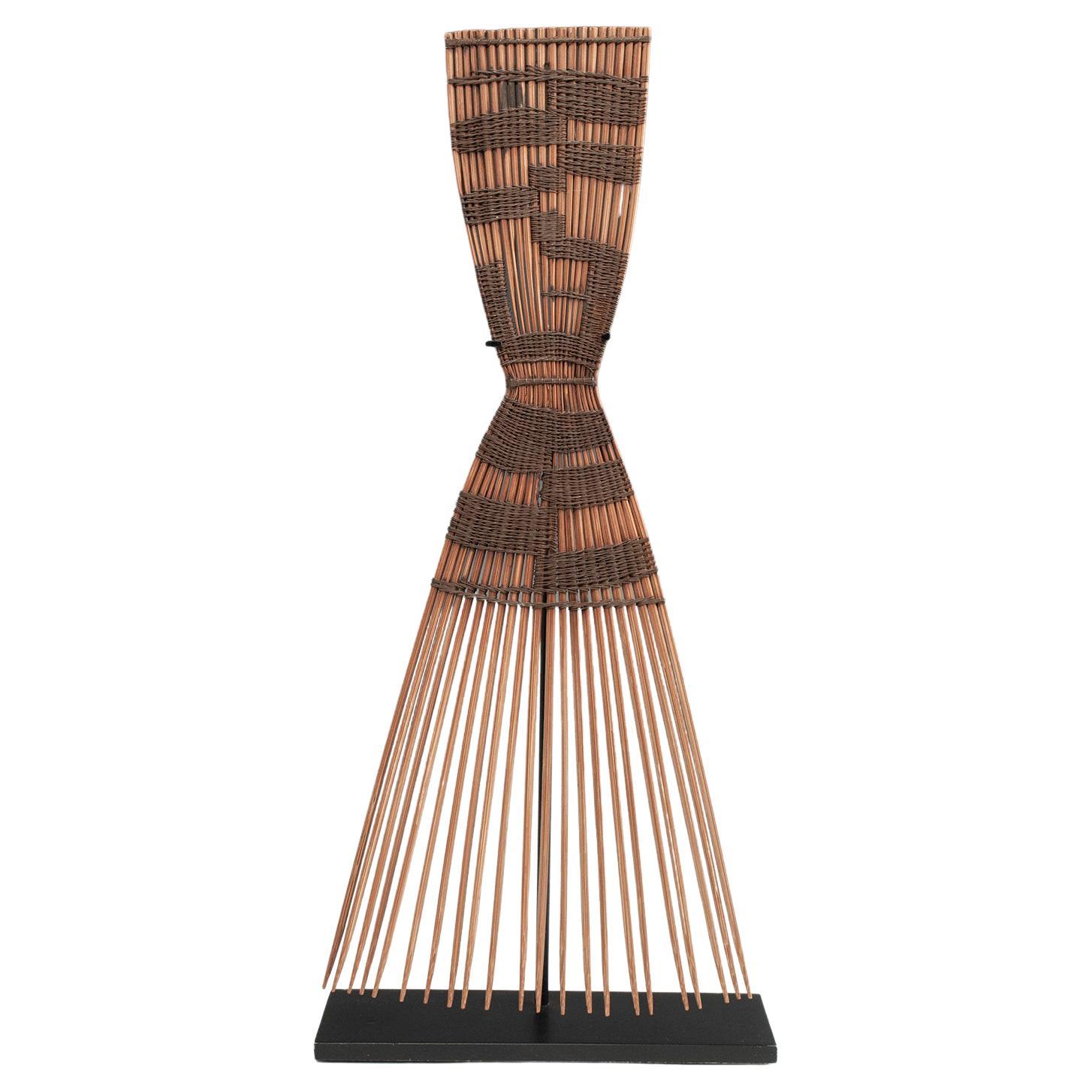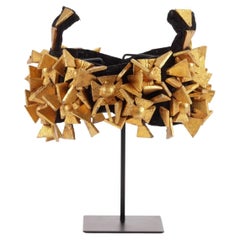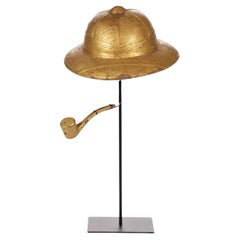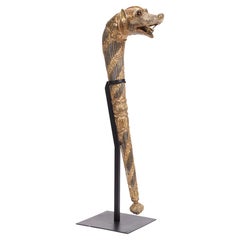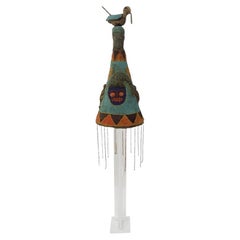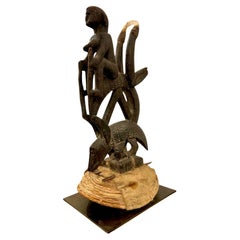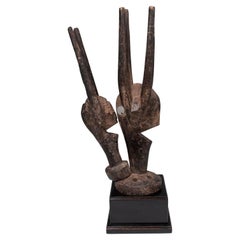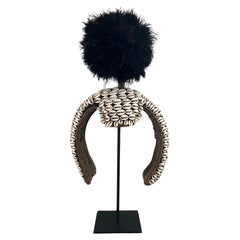Items Similar to Ashanti African Chief’s ceremonial gold and gilt-metal crown and sash on stand
Want more images or videos?
Request additional images or videos from the seller
1 of 10
Ashanti African Chief’s ceremonial gold and gilt-metal crown and sash on stand
$9,500
£7,208.38
€8,242.14
CA$13,268.92
A$14,753.24
CHF 7,703.33
MX$179,582.83
NOK 98,291.10
SEK 92,094.06
DKK 61,512.60
Shipping
Retrieving quote...The 1stDibs Promise:
Authenticity Guarantee,
Money-Back Guarantee,
24-Hour Cancellation
About the Item
An Ashanti Chief’s ceremonial gold and gilt-metal crown and sash
Ghana, early 20th century
Diam. 20 cm (crown)
L. 128 cm (sash)
H. 102 cm (incl. stand)
Provenance:
Private collection, Paris
The sash, in gold and gilt-metal on velvet, is completely of traditional Ashanti form. The filigree crown however in our opinion shows clear influence from the Art Nouveau styles in vogue in Europe in the early 20th century.
Rivalry between the Ashanti Kings or Chiefs was, and still is, common in the region. A chief, who before flaunted with a traditional crown, clearly thought the ‘fashionable’ Pith helmet of a European colonialist or visitor would outshine the crown of his neighbouring competitor. Certainly, this gilt wood version, together with a sceptre in the form of a European pipe, did the job. Nowadays, Bouelé people are still seen wearing fashionable designer brand sunglasses, purses, or other accessories, all made of gilt wood.
- Dimensions:Height: 43.31 in (110 cm)Width: 15.75 in (40 cm)Depth: 15.75 in (40 cm)
- Style:Art Nouveau (Of the Period)
- Materials and Techniques:
- Place of Origin:
- Period:
- Date of Manufacture:Circa 1900
- Condition:Wear consistent with age and use. The star at the top misses one part, possibly already happened during use and sold to a European because of it.
- Seller Location:Amsterdam, NL
- Reference Number:1stDibs: LU5458233745072
About the Seller
5.0
Recognized Seller
These prestigious sellers are industry leaders and represent the highest echelon for item quality and design.
Established in 1985
1stDibs seller since 2020
23 sales on 1stDibs
Typical response time: 2 hours
- ShippingRetrieving quote...Shipping from: Amsterdam, Netherlands
- Return Policy
Authenticity Guarantee
In the unlikely event there’s an issue with an item’s authenticity, contact us within 1 year for a full refund. DetailsMoney-Back Guarantee
If your item is not as described, is damaged in transit, or does not arrive, contact us within 7 days for a full refund. Details24-Hour Cancellation
You have a 24-hour grace period in which to reconsider your purchase, with no questions asked.Vetted Professional Sellers
Our world-class sellers must adhere to strict standards for service and quality, maintaining the integrity of our listings.Price-Match Guarantee
If you find that a seller listed the same item for a lower price elsewhere, we’ll match it.Trusted Global Delivery
Our best-in-class carrier network provides specialized shipping options worldwide, including custom delivery.More From This Seller
View AllTraditional Ashanti African Chief’s velvet and gilt-wood Leopard crown on stand
Located in Amsterdam, NL
A traditional Ashanti Chief’s velvet and giltwood Leopard crown
Ghana, early 20th century
Diam. 17 cm (crown)
H. 27 cm (incl. stand)
Provenance:
Pri...
Category
Early 20th Century Ghanaian Antiquities
Materials
Velvet, Giltwood
African Chief’s gilt Crown and Sceptre in the form of a Pith helmet and pipe
Located in Amsterdam, NL
A splendid Bouelé Chief’s gilt-wood crown and sceptre in the form of a Pith helmet and pipe
Ivory coast, late 19th/early 20th century
H. 13 x L. 33.5 x D. 26 cm (crown)
L. 14 cm ...
Category
Antique Early 1900s Ivorian Tribal Art
Materials
Giltwood
A bridal headdress from Papua called 'ambusap'
Located in Amsterdam, NL
Iatmul, Papua New Guinea, 20th century
This ceremonial headdress is traditionally worn by a young bride as she enters her new husband’s home for the first time. Adorned with shells—...
Category
Antique 19th Century Papua New Guinean Tribal Art
Materials
Shell, Natural Fiber
An Indian part-gilt silver-clad ceremonial sceptre or mace with a tiger’s head
Located in Amsterdam, NL
Northern India or Deccan, late 19th century
L. approx. 82 cm (excl. stand)
Provenance:
Private collection, United Kingdom
This remarkable gilt-silver soonta (ceremonial sceptre) also known as choba (ceremonial mace) with a tiger's head stands out as an unparalleled example. It has a wooden base, clad with thick sheet part-gilt silver and has fine details such as teeth and a curling tongue. Especially with the inlaid glass eyes, in combination with the grand sculptural design, it would have been integral to an Indian maharaja’s attire, known as lawajama in North India and biruthus in South India, as referenced by Jackson & Jaffer. They would symbolise authority, power, and sometimes an attribute of various deities, particularly those associated with strength or combat. For instance, the Hindu god Hanuman, known for his immense strength, is often depicted holding a mace (*chob* or gada in Sanskrit). Similarly, the god Vishnu and his avatar Krishna are also frequently depicted with a mace among their other attributes.
Courtiers would raise these sceptres wrapped in rich brocades, with the head visible, during processions, signalling their association with the monarch. Alongside fly-whisks and standards, they were indispensable in ceremonial parades, underscoring the ruler's prestige. Terlinden notes that a soonta berdar was tasked with carrying the sceptre. These individuals, proficient in courtly manners, played key roles during audiences, from managing entrances to introducing guests. Their esteemed position often earned them generous rewards, including land grants. See for a depiction of sceptres in use the top right of a painting in the collection of the V&A, titled Processional scene with Amar Singh, ruler of Thanjavur (Tanjore), and Sarabhoji, from circa 1797.
For a very comparable piece, but with an elephant’s head, see the collection of the Indian Museum, Kolkata. For other less similar examples, see the V&A Museum London.
Sources:
A. Jackson & A. Jaffer, Maharaja: The Splendour of India’s Royal Courts, London, V&A Publishing, 1999
Christiane Terlinden Serra, Mughal Silver...
Category
Antique Late 19th Century Indian Metalwork
Materials
Silver
An elaborate Minangkabau gem-set brass floral wedding crown or 'Suntiang'
Located in Amsterdam, NL
An elaborate Minangkabau gem-set brass floral wedding crown or 'Suntiang'
West Sumatra, Minangkabau, probably 1st half 20th century
H. 66.5 cm (incl. stand)
Provenance: Private co...
Category
Mid-20th Century Indonesian Metalwork
Materials
Brass, Enamel
A Huli wigman's ceremonial headdress
Located in Amsterdam, NL
Papua New Guinea, Central Highlands, Huli people, 1st half 20th century
Crafted from the wearer’s own hair and adorned with colorful bird-of-paradise feathers, flowers, scarab beetl...
Category
20th Century Papua New Guinean Tribal Art
Materials
Shell, Feathers
You May Also Like
Yoruba Nigeria African Royal Beaded Headdress Crown on Lucite Stand
Located in North Hollywood, CA
West African hand beaded head dress crown from Yoruba, Nigeria.
This artistic beautiful and functional art piece is covered with beads in turquoise, orange, green, yellow red, blue ...
Category
Mid-20th Century Nigerian Tribal Tribal Art
Materials
Metal
Ciwara Bambara headdress in carved wood and basketry, Mali, Early 20th century
Located in NICE, FR
A very pleasing Ciwara crest, singularly small and accompanied by its original headdress, depicting a stylized antelope leaning on a pangolin. The antelope is ridden by a woman, and white horsehair has been added to the tips of the horns. The piece is carefully sculpted, with notches decorating the bodies of the antelope and the pangolin.
Rattan, plant fiber, cowries, wood Very fine velvety mat patina, Circa 1950
An animal called Ciwara is said to have taught the Bambara how to cultivate the land, and during agrarian ceremonies, they recall the myth through the stylized representation of an antelope whose name ci wara...
Category
Early 20th Century Malian Tribal Tribal Art
Materials
Wood
Early 20th Century Chiwara Headdress, Bamana 'Bambara' People, Mali
Located in Point Richmond, CA
Early 20th century Chiwara Headdress, Bamana (Bambara) People, Mali
Chiwara headcrests represent the antelope spirit who taught the Bamana people ...
Category
Early 20th Century Malian Tribal Mounted Objects
Materials
Wood
20th Century Vintage Bamileke Headdress Mounted on Stand
Located in Chicago, IL
Bamileke headdress, originating from the Bamileke ethnic group in Cameroon, is ceremonial and symbolic artifacts used in traditional ceremonies and rituals. It is crafted using natur...
Category
20th Century Cameroonian Tribal Art
Materials
Shell, Fabric, Feathers
Mid-20th Century Ceremonial Comb, Luba People, Zaire, D. R. Congo
Located in Point Richmond, CA
Ceremonial comb, Luba People, Zaire, D. R. Congo
Made of palm leaf midribs, this large, graphic comb has a pinched waist and is held together with finely wrapped wire. Presented o...
Category
Mid-20th Century Congolese Tribal Tribal Art
Materials
Wire
Bamileke Decorative Dance Crest, embroidered with European Glass Beads
Located in Leuven , BE
Bamileke Decorative Dance Crest, embroidered with European Glass Beads, Grasslands People, Cameroon.
Private collection Brussels
The raffia splint is covered with cloth and colou...
Category
Mid-20th Century Cameroonian Figurative Sculptures
Materials
Beads
